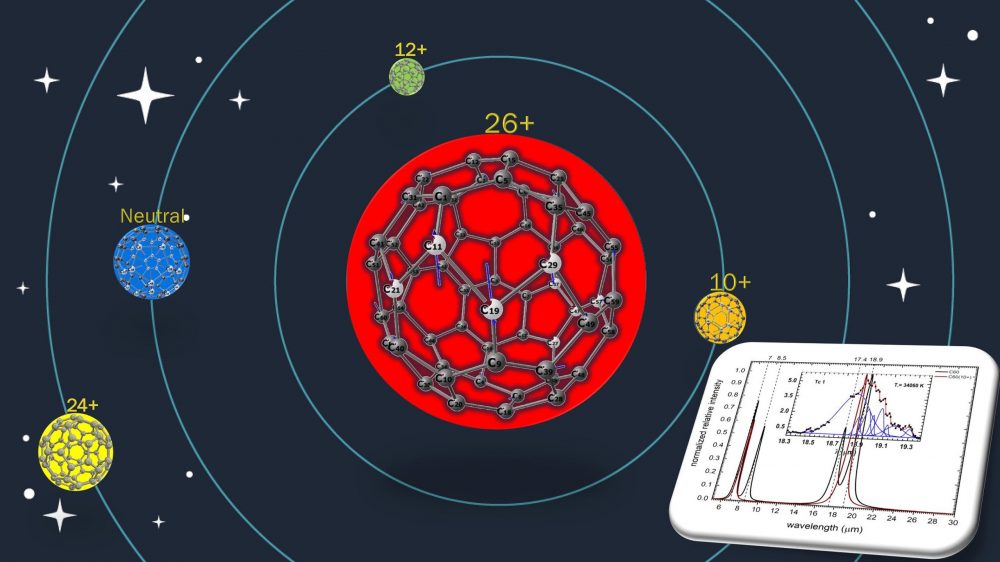HKU Laboratory for Space Research put a positive spin on the Buckyball ‘C60’: Its potential for high level ionisation and as the origin for some of the Mysterious Unidentified Infrared Emission Bands seen in the Universe
Image: Solar system illustration of the C60 and some of its highly positively charged cations, representing theoretically calculated normal modes vibration motions and relative molecular sizes (volumes). C6010+, the little bucky, is the only charged fullerene inherited from the symmetry of C60. The bottom right corner is the theoretically predicated IR fingerprint of this exotic species (brown profile), overlapped onto the astronomically observed emission spectrum of Tc1 planetary nebula within the same wavelength region.
Image Credit: SeyedAbdolreza Sadjadi and Quentin Andrew Parker
Is there now at long last some plausible theoretical basis for the molecular origins and carriers of at least some of the most prominent so called ‘UIE’ (unidentified Infrared Emission) bands that have mystified astronomers for decades?
The theoretical astrophysicists and astrochemists at the Laboratory for Space Research (LSR) and Department of Physics at The University of Hong Kong (HKU) seem to think so (at least in theory) in a peer-reviewed paper just published in the prestigious ‘The Astrophysical Journal.’
A team led by Dr SeyedAbdolreza SADJADI, member of the LSR, and Professor Quentin PARKER, Director of the LSR in the Department of Physics, has now placed some interesting theoretical work into the mix. It identifies highly ionised species of the famous football shaped ‘Buckminster’ fullerene C60 molecule as plausible carriers of at least some of the most prominent and enigmatic UIE bands that have challenged astronomers since they were first discovered and studied over 30 years ago.
First, Dr Sadjadi and Professor Parker proved theoretically that C60 could survive, in stable states, from being ionised up to +26 (i.e. 26 of the 60 electrons in the buckyball being removed) before the buckyball disintegrates (Sadjadi & Parker 2021). Now they have shown, via applying first principles quantum chemical calculations, what theoretical mid-infrared signatures of these ionised forms of fullerene can be expected. The results are extremely interesting and provocative and may at last point the way forward to at least a partial resolution of this enduring astrophysical mystery.
Professor Parker said, ‘I am extremely honoured to have played a part in the astonishingly complex quantum chemistry investigations undertaken by Dr Sadjadi that have led to these very exciting results. They concern first the theoretical proof that Fullerene–Carbon 60–can survive to very high levels of ionisation and now this work shows the infrared emission signatures from such species are an excellent match for some of the most prominent Unidentified Infrared Emission features known. This should help re-invigorate this area of research.’
The HKU lead team found that some of these positively charged fullerenes show strong emission bands that match extremely well the position of key astronomical UIE emission features at 11.21, 16.40 and 20-21 micrometers (μm). This makes them key target species for identification of the currently unidentified UIE features and provides strong motivation for future astronomical observations across the mid infrared wavelength range to test these theoretical findings. They also found that the IR signatures of the group of these C60 cations with q = 1 − 6 are well separated from the 6.2 μm bands, that are associated with free/isolated aromatic hydrocarbon molecules (so called PAH’s, another potential carrier of UIE). This significantly aids in their identification from other potential carriers. This finding is particularly important for discrimination and exploration of the coexistence of complex hydrocarbon organics and fullerenes in astronomical sources.
Dr Sadjadi said, ‘In our first paper we showed theoretically that highly ionised fullerenes can exist and survive the harsh and chaotic environment of space. It is like asking how much air you can push out of a football ball and the ball still maintains its shape. In this paper we worked with two other leading astrophysicists and planetary scientists Professor Yong ZHANG and Dr Chih-Hao HSIA , both ex-HKU staff but still affiliated to the LSR, to determine the molecular vibrational notes of a celestial symphony, ie the spectral features that these ionised buckyballs would play/produce. We then hunted for them in space showing their notes/signatures are easily distinguishable from PAHs.’
The journal paper can be accessed here: https://iopscience.iop.org/article/10.3847/1538-4357/ac75d5
Images download and captions: https://www.scifac.hku.hk/press
For media enquiries, please contact Ms Casey To, External Relations Officer (Tel: 3917-4948; email: caseyto@hku.hk) and Ms Cindy Chan, Assistant Communications Director of Faculty of Science (Tel: 3917-5286; email: cindycst@hku.hk).
Reference:
1. It remains a cage: ionisation tolerance of C60 fullerene in planetary nebulae
Sadjadi, SeyedAbdolreza ; Parker, Quentin Andrew in Fullerenes, Nanotubes and Carbon Nanostructures, vol. 29, issue 8, pp. 620-625; Pub Date:August 2021


